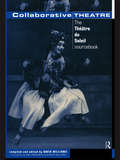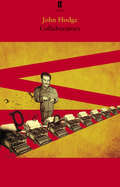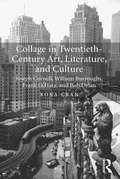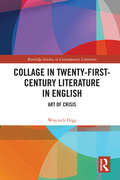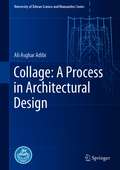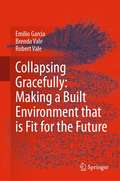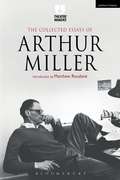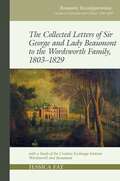- Table View
- List View
Collaborative Theatre: Le Theatre du Soleil
by Eric Prenowitz David WilliamsOver the past thirty years Ariane Mnouchkine's 'Théâtre du Soleil' has become one of the most celebrated companies in Europe, and Mnouchkine one of its best-known directors. Collaborative Theatre is the first in-depth sourcebook in English on 'Théâtre du Soleil', providing English readers with first-hand accounts of the development of its collectivist practices and ideals.Collaborative Theatre presents critical and historical essays by theatre scholars from around the world as well as the writings of and interviews with members of le Théâtre du Soleil, past and present. Projects discussed include: 1789, L'Age d'Or, Richard II, L'Indiade and Les Atriades.
Collaborative Theatre: Le Theatre du Soleil
by David WilliamsOver the past thirty years Ariane Mnouchkine's 'Théâtre du Soleil' has become one of the most celebrated companies in Europe, and Mnouchkine one of its best-known directors. Collaborative Theatre is the first in-depth sourcebook in English on 'Théâtre du Soleil', providing English readers with first-hand accounts of the development of its collectivist practices and ideals.Collaborative Theatre presents critical and historical essays by theatre scholars from around the world as well as the writings of and interviews with members of le Théâtre du Soleil, past and present. Projects discussed include: 1789, L'Age d'Or, Richard II, L'Indiade and Les Atriades.
Collaborators (Books That Changed The World Ser.)
by John HodgeMoscow, 1938. A dangerous place to have a sense of humour; even more so a sense of freedom. Mikhail Bulgakov, living among dissidents, stalked by secret police, has both. And then he's offered a poisoned chalice: a commission to write a play about Stalin to celebrate his sixtieth birthday.Inspired by historical fact, Collaborators embarks on a surreal journey into the fevered imagination of the writer as he loses himself in a macabre and disturbingly funny relationship with the omnipotent subject of his drama.Killing my enemies is easy. The challenge is to change the way they think, to control their minds. And I think I controlled yours pretty well. In years to come, I'll be able to say: Bulgakov? Yeah, we even trained him. He gave up. He saw the light. We broke him, we can break anybody. It's man versus monster, Mikhail. And the monster always wins.John Hodge's blistering new play depicts a lethal game of cat and mouse through which the appalling compromises and humiliations inflicted on any artist by those with power are held up to scrutiny.Collaborators by John Hodge premiered at the National Theatre, London, in October 2011. It is published here with an introduction by the author.
The Collaborators: Interactions in the Architectural Design Process (Ashgate Studies in Architecture)
by Gilbert Herbert Mark DonchinIllustrated by critical analyses of significant buildings, including examples by such eminent architects as Adler and Sullivan, Erich Mendelsohn, and Louis Kahn, this book examines collaboration in the architectural design process over a period ranging from the mid-19th century to the late 1960s. The examples chosen, located in England, the United States, Israel and South Africa, are of international scope. They have intrinsic interest as works of architecture, and illustrate all facets of collaboration, involving architects, engineers and clients. Prior to dealing with the case studies the theoretical framework is set in three introductory essays which discuss in general terms the organizational implications of partnerships, associations and teams; the nature of interactions between architect and engineer; and cooperation and confrontation in the relationship between architect and client. From this original standpoint, the interactive role of the designers, it examines and reinterprets such well-known buildings as the Chicago Auditorium and the Kimbell Art Museum. The re-evaluation of St Pancras Station and its hotel questions common presumptions about the separation of professional roles played by its engineer and architect. The account of the troubled history of Mendelsohn’s project for the first Haifa Power House highlights the difficulties that arise when a determined and eminent architect confronts a powerful and demanding client. In a later era, the examination of the John Moffat Building, which is less well known but deserving of wider recognition, reveals how the fruitful collaboration of multiple architects can result in a successful unified design. These case studies comprise a wide range of programmes, challenges, personalities and interactions. Ultimately, in five different ways, in five different epochs, and in five different circumstantial and cultural contexts, this book shows how the dialogue between the players in the design process resonates upo
The Collaborators: Interactions in the Architectural Design Process (Ashgate Studies in Architecture)
by Gilbert Herbert Mark DonchinIllustrated by critical analyses of significant buildings, including examples by such eminent architects as Adler and Sullivan, Erich Mendelsohn, and Louis Kahn, this book examines collaboration in the architectural design process over a period ranging from the mid-19th century to the late 1960s. The examples chosen, located in England, the United States, Israel and South Africa, are of international scope. They have intrinsic interest as works of architecture, and illustrate all facets of collaboration, involving architects, engineers and clients. Prior to dealing with the case studies the theoretical framework is set in three introductory essays which discuss in general terms the organizational implications of partnerships, associations and teams; the nature of interactions between architect and engineer; and cooperation and confrontation in the relationship between architect and client. From this original standpoint, the interactive role of the designers, it examines and reinterprets such well-known buildings as the Chicago Auditorium and the Kimbell Art Museum. The re-evaluation of St Pancras Station and its hotel questions common presumptions about the separation of professional roles played by its engineer and architect. The account of the troubled history of Mendelsohn’s project for the first Haifa Power House highlights the difficulties that arise when a determined and eminent architect confronts a powerful and demanding client. In a later era, the examination of the John Moffat Building, which is less well known but deserving of wider recognition, reveals how the fruitful collaboration of multiple architects can result in a successful unified design. These case studies comprise a wide range of programmes, challenges, personalities and interactions. Ultimately, in five different ways, in five different epochs, and in five different circumstantial and cultural contexts, this book shows how the dialogue between the players in the design process resonates upo
COLLADA: Sailing the Gulf of 3D Digital Content Creation
by Remi Arnaud Mark C. BarnesCOLLADA is a COLLAborative Design Activity for establishing an open standard Digital Asset schema for interactive 3D applications. This book explains in detail how to use the COLLADA technology in a project utilizing 3D assets, and ultimately how to create an effective content creation pipeline for the most complex development. Errata are posted at
Collage and Architecture
by Jennifer A.E. ShieldsCollage and Architecture is the first book to cover collage as a tool for design?in architecture, making it a valuable resource for students and practitioners. Author Jennifer Shields uses the artworks and built projects of leading artists and architects, such as Le Corbusier, Daniel Libeskind, and Teddy Cruz to illustrate the diversity of collage techniques. The six case study projects from Mexico, Argentina, Sweden, Norway, the United States, and Spain give you a global perspective of architecture as collage. Collage is an important instrument for analysis and design, and Shields’s presentation of this?versatile?medium draws on decades of relevance in art and architecture, to be?adapted?and transformed in your own work.
Collage and Architecture
by Jennifer A.E. ShieldsCollage and Architecture is the first book to cover collage as a tool for design?in architecture, making it a valuable resource for students and practitioners. Author Jennifer Shields uses the artworks and built projects of leading artists and architects, such as Le Corbusier, Daniel Libeskind, and Teddy Cruz to illustrate the diversity of collage techniques. The six case study projects from Mexico, Argentina, Sweden, Norway, the United States, and Spain give you a global perspective of architecture as collage. Collage is an important instrument for analysis and design, and Shields’s presentation of this?versatile?medium draws on decades of relevance in art and architecture, to be?adapted?and transformed in your own work.
Collage and Architecture
by Jennifer A.E. ShieldsCollage and Architecture remains an invaluable resource for students and practitioners as the first book to cover collage as a tool for analysis and design in architecture. Since entering the contemporary art world over a century ago, collage has profoundly influenced artists and architects throughout the twentieth century and into the twenty-first. In Collage and Architecture, Jennifer A. E. Shields explores its influence, using the artworks and built projects of leading artists and architects, such as Mies van der Rohe, Daniel Libeskind, and Teddy Cruz to illustrate the diversity of collage techniques. This new edition includes: A stronger focus on contemporary practices, including digital methods; New designers and architects, including Marshall Brown, WAI Architecture Think Tank, and Tatiana Bilbao, bringing their methods and work to life; An expanded global and diverse perspective of architecture as collage; Collage is an important instrument for analysis and design. Through its 261 color images, this book shows how this versatile medium can be adapted and transformed in your own work.
Collage and Architecture
by Jennifer A.E. ShieldsCollage and Architecture remains an invaluable resource for students and practitioners as the first book to cover collage as a tool for analysis and design in architecture. Since entering the contemporary art world over a century ago, collage has profoundly influenced artists and architects throughout the twentieth century and into the twenty-first. In Collage and Architecture, Jennifer A. E. Shields explores its influence, using the artworks and built projects of leading artists and architects, such as Mies van der Rohe, Daniel Libeskind, and Teddy Cruz to illustrate the diversity of collage techniques. This new edition includes: A stronger focus on contemporary practices, including digital methods; New designers and architects, including Marshall Brown, WAI Architecture Think Tank, and Tatiana Bilbao, bringing their methods and work to life; An expanded global and diverse perspective of architecture as collage; Collage is an important instrument for analysis and design. Through its 261 color images, this book shows how this versatile medium can be adapted and transformed in your own work.
Collage Colour and Texture in Painting: Mixed Media Techniques For Artists
by Mike Bernard, Robin CaponCollage Culture: Readymades, Meaning, And The Age Of Consumption (Postmodern Studies (PDF) #49)
by David Banash<I>Collage Culture</I> develops a comprehensive theory of the origins and meanings of collage and readymades in modern and postmodern art, literature, and everyday life. Demonstrating that the origins of collage are found in assembly line technologies and mass media forms of layout and advertising in early twentieth-century newspapers, <I>Collage Culture</I> traces how the historical avant-garde turns the fragmentation of Fordist production against nationalist, fascist, and capitalist ideologies, using the radical potential unleashed by new technologies to produce critical collages. David Banash adeptly surveys the reinvention of collage by a generation of postmodern artists who develop new forms including cut-ups, sampling, zines, plagiarism, and copying to cope with the banalities and demands of consumer culture. Banash argues that collage mirrors the profoundly dialectical relations between the cut of assembly lines and the readymades of consumerism even as its cutting-edges move against the imperatives of passive consumption and disposability instituted by those technologies, forms, and relations. <I>Collage Culture</I> surveys and analyzes works of advertising, assemblage, film, literature, music, painting, and photography from the historical avant-garde to the most recent developments of postmodernism.
Collage in Twentieth-Century Art, Literature, and Culture: Joseph Cornell, William Burroughs, Frank O’Hara, and Bob Dylan
by Rona CranEmphasizing the diversity of twentieth-century collage practices, Rona Cran's book explores the role that it played in the work of Joseph Cornell, William Burroughs, Frank O'Hara, and Bob Dylan. For all four, collage was an important creative catalyst, employed cathartically, aggressively, and experimentally. Collage's catalytic effect, Cran argues, enabled each to overcome a potentially destabilizing crisis in representation. Cornell, convinced that he was an artist and yet hampered by his inability to draw or paint, used collage to gain access to the art world and to show what he was capable of given the right medium. Burroughs' formal problems with linear composition were turned to his advantage by collage, which enabled him to move beyond narrative and chronological requirement. O'Hara used collage to navigate an effective path between plastic art and literature, and to choose the facets of each which best suited his compositional style. Bob Dylan's self-conscious application of collage techniques elevated his brand of rock-and-roll to a level of heightened aestheticism. Throughout her book, Cran shows that to delineate collage stringently as one thing or another is to severely limit our understanding of the work of the artists and writers who came to use it in non-traditional ways.
Collage in Twentieth-Century Art, Literature, and Culture: Joseph Cornell, William Burroughs, Frank O’Hara, and Bob Dylan
by Rona CranEmphasizing the diversity of twentieth-century collage practices, Rona Cran's book explores the role that it played in the work of Joseph Cornell, William Burroughs, Frank O'Hara, and Bob Dylan. For all four, collage was an important creative catalyst, employed cathartically, aggressively, and experimentally. Collage's catalytic effect, Cran argues, enabled each to overcome a potentially destabilizing crisis in representation. Cornell, convinced that he was an artist and yet hampered by his inability to draw or paint, used collage to gain access to the art world and to show what he was capable of given the right medium. Burroughs' formal problems with linear composition were turned to his advantage by collage, which enabled him to move beyond narrative and chronological requirement. O'Hara used collage to navigate an effective path between plastic art and literature, and to choose the facets of each which best suited his compositional style. Bob Dylan's self-conscious application of collage techniques elevated his brand of rock-and-roll to a level of heightened aestheticism. Throughout her book, Cran shows that to delineate collage stringently as one thing or another is to severely limit our understanding of the work of the artists and writers who came to use it in non-traditional ways.
Collage in Twenty-First-Century Literature in English: Art of Crisis (Routledge Studies in Contemporary Literature)
by Wojciech DragCollage in Twenty-First-Century Literature in English: Art of Crisis considers the phenomenon of the continued relevance of collage, a form established over a hundred years ago, to contemporary literature. It argues that collage is a perfect artistic vehicle to represent the crisis-ridden reality of the twenty-first-century. Being a mixture of fragmentary incompatible voices, collage embodies the chaos of the media-dominated world. Examining the artistic, sociopolitical and personal crises addressed in contemporary collage literature, the book argues that the 21st Century has brought a revival of collage-like novels and essays.
Collage in Twenty-First-Century Literature in English: Art of Crisis (Routledge Studies in Contemporary Literature)
by Wojciech DragCollage in Twenty-First-Century Literature in English: Art of Crisis considers the phenomenon of the continued relevance of collage, a form established over a hundred years ago, to contemporary literature. It argues that collage is a perfect artistic vehicle to represent the crisis-ridden reality of the twenty-first-century. Being a mixture of fragmentary incompatible voices, collage embodies the chaos of the media-dominated world. Examining the artistic, sociopolitical and personal crises addressed in contemporary collage literature, the book argues that the 21st Century has brought a revival of collage-like novels and essays.
Collage: A Process in Architectural Design (University of Tehran Science and Humanities Series)
by Ali Asghar AdibiThis book is about using “collage” among Iranian students in architecture studio, and in order to introduce the way these students use the technique to the English reader, we (Ali Yaser Jafari and Reihaneh Khorramrouei) have chosen this valuable book by AliAsghar Adibi to translate from Farsi to English. It provides a representative example of design through collage and culture. This book originally collected and published in three chapters: Collage history in different arts; Objectives and steps to make collage images; Two experienced examples.
Collage Your Life: Techniques, Prompts, and Inspiration for Creative Self-Expression and Visual Storytelling
by Melanie MowinskiRequiring minimal equipment--just scissors, glue, paper, and pens--collage is an accessible craft that offers limitless creative possibilities. Like meditation or journaling, making collage can be an avenue for self-reflection and artistic exploration. In Collage Your Life, artist and teacher Melanie Mowinski teaches a variety of core techniques including lettering, stamping, stenciling, transfers, and adhesive methods, and provides dozens of prompts to jumpstart the creative process and encourage crafters to explore the versatility of collage, such as: make a self-portrait; disrupt your routine instincts; incorporate text; assemble mementos from a trip; process anger or anxiety; collage with others; or try creating block-out poetry with pages from a magazine. Inspiring examples of the author's work along with that of other collage artists are featured throughout. Crafters, journaling fans, scrapbookers, and artists alike will find guidance and support for developing their own distinctive collage style, whether the goal is to create a visual record of daily experiences and special occasions or to expand a creative journaling practice. This publication conforms to the EPUB Accessibility specification at WCAG 2.0 Level AA.
Collapsing Gracefully: Making a Built Environment that is Fit for the Future
by Emilio Garcia Brenda Vale Robert ValeThis innovative book investigates the concept of collapse in terms of our built environment, exploring the future transition of modern cities towards scenarios very different from the current promises of progress and development. This is not a book about the end of the world and hopeless apocalyptic scenarios. It is about understanding change in how and where we live. Collapse is inevitable, but in the built environment collapse could imply a manageable situation, an opportunity for change or a devastating reality. Collapsing gracefully means that there might be better ways to coexist with collapse if we learn more about it and commit to rebuild our civilisations in ways that avoid its worst effects. This book uses a wide range of practical examples to study critical changes in the built environment, to contextualise and visualise what collapse looks like, to see if it is possible to buffer its effects in places already collapsing and to propose ways to develop greater resilience.The book challenges all agents and institutions in modern cities, their designers and planners as well as their residents and users to think differently about built environment so as to ease our coexistence with collapse and not contribute to its causes. .
The Collected Essays And Criticism: Modernism With A Vengeance, 1957-1969
by Clement Greenberg John O'Brianlement Greenberg is widely recognized as the most influential and articulate champion of modernism during its American ascendency after World War II, the period largely covered by these highly acclaimed volumes of _The Collected Essays and Criticism_. _Volume 3: Affirmations and Refusals_ presents Greenberg's writings from the period between 1950 and 1956, while _Volume 4: Modernism with a Vengeance_ gathers essays and criticism of the years 1957 to 1969. The 120 works range from little-known pieces originally appearing _Vogue_ and _Harper's Bazaar_ to such celebrated essays as "The Plight of Our Culture" (1953), "Modernist Painting" (1960), and "Post Painterly Abstraction" (1964). Preserved in their original form, these writings allow readers to witness the development and direction of Greenberg's criticism, from his advocacy of abstract expressionism to his enthusiasm for color-field painting.With the inclusion of critical exchanges between Greenberg and F. R. Leavis, Fairfield Porter, Thomas B. Hess, Herbert Read, Max Kozloff, and Robert Goldwater, these volumes are essential sources in the ongoing debate over modern art.
The Collected Essays and Criticism, Volume 2: Arrogant Purpose, 1945-1949
by Clement GreenbergClement Greenberg (1909–1994), champion of abstract expressionism and modernism—of Pollock, Miró, and Matisse—has been esteemed by many as the greatest art critic of the second half of the twentieth century, and possibly the greatest art critic of all time. On radio and in print, Greenberg was the voice of "the new American painting," and a central figure in the postwar cultural history of the United States.Greenberg first established his reputation writing for the Partisan Review, which he joined as an editor in 1940. He became art critic for the Nation in 1942, and was associate editor of Commentary from 1945 until 1957. His seminal essay, "Avant-Garde and Kitsch" set the terms for the ongoing debate about the relationship of modern high art to popular culture. Though many of his ideas have been challenged, Greenberg has influenced generations of critics, historians, and artists, and he remains influential to this day.
The Collected Essays and Criticism, Volume 4: Modernism with a Vengeance, 1957-1969
by Clement GreenbergClement Greenberg is widely recognized as the most influential and articulate champion of modernism during its American ascendency after World War II, the period largely covered by these highly acclaimed volumes of The Collected Essays and Criticism. Volume 3: Affirmations and Refusals presents Greenberg's writings from the period between 1950 and 1956, while Volume 4: Modernism with a Vengeance gathers essays and criticism of the years 1957 to 1969. The 120 works range from little-known pieces originally appearing Vogue and Harper's Bazaar to such celebrated essays as "The Plight of Our Culture" (1953), "Modernist Painting" (1960), and "Post Painterly Abstraction" (1964). Preserved in their original form, these writings allow readers to witness the development and direction of Greenberg's criticism, from his advocacy of abstract expressionism to his enthusiasm for color-field painting. With the inclusion of critical exchanges between Greenberg and F. R. Leavis, Fairfield Porter, Thomas B. Hess, Herbert Read, Max Kozloff, and Robert Goldwater, these volumes are essential sources in the ongoing debate over modern art. For each volume, John O'Brian has furnished an introduction, a selected bibliography, and a brief summary of events that places the criticism in its artistic and historical context.
The Collected Essays of Arthur Miller (Theatre Makers)
by Arthur MillerThis comprehensive volume brings together essays by one of the most influential literary, cultural and intellectual voices of our time: Arthur Miller. Arranged chronologically from 1944 to 2000, these writings take the reader on a whirlwind tour of modern history alongside offering a remarkable record of Miller's views on theater. They give eloquent expression to his belief in 'the theater as a serious business, one that makes or should make man more human, which is to say, less alone'. Published with the essays are articles that Miller had written and in-depth interviews he has given.This collection features material from two earlier publications: Echoes Down the Corridor and The Theater Essays of Arthur Miller. It is edited and features a new introduction by Matthew Roudané, Regents Professor of American Drama at Georgia State University. 'Arthur Miller understands that serious writing is a social act as well as an aesthetic one, that political involvement comes with the territory. A writer's work and his actions should be of the same cloth, after all. His plays and his conscience are a cold burning force.' Edward Albee
The Collected Essays of Arthur Miller (Theatre Makers)
by Arthur Miller Matthew C. RoudanéThis comprehensive volume brings together essays by one of the most influential literary, cultural and intellectual voices of our time: Arthur Miller. Arranged chronologically from 1944 to 2000, these writings take the reader on a whirlwind tour of modern history alongside offering a remarkable record of Miller's views on theater. They give eloquent expression to his belief in 'the theater as a serious business, one that makes or should make man more human, which is to say, less alone'. Published with the essays are articles that Miller had written and in-depth interviews he has given.This collection features material from two earlier publications: Echoes Down the Corridor and The Theater Essays of Arthur Miller. It is edited and features a new introduction by Matthew Roudané, Regents Professor of American Drama at Georgia State University. 'Arthur Miller understands that serious writing is a social act as well as an aesthetic one, that political involvement comes with the territory. A writer's work and his actions should be of the same cloth, after all. His plays and his conscience are a cold burning force.' Edward Albee
The Collected Letters of Sir George and Lady Beaumont to the Wordsworth Family, 1803–1829: with a Study of the Creative Exchange between Wordsworth and Beaumont (Romantic Reconfigurations: Studies in Literature and Culture 1780-1850 #14)
Sir George Beaumont is a key figure in the history of British art. As well as being a respected amateur landscape painter, he was a prominent patron, a collector, and co-founder of the National Gallery. William Wordsworth described Beaumont’s friendship as one of the chief blessings of his life, and this edition reveals that the two men became collaborators as well as companions. In addition to documenting unique perspectives on social, political, and cultural events of the early nineteenth century (providing new contexts for reading Wordsworth’s mature poetry), the letters collected here chart the progress of an increasingly intimate inter-familial relationship. The picture that emerges is of a coterie that – in influence, creativity, and affection – rivals Wordsworth’s more famous exchange with Coleridge at Nether Stowey in the 1790s. The edition includes an extended study of how Wordsworth and Beaumont helped shape one another’s work, tracing processes of mutual artistic development that involved not only a meeting of aristocratic refinement and rural simplicity, of a socialite and a lover of retirement, of a painter and a poet, but also an aesthetic rapprochement between neoclassical and romantic values, between the impulse to idealize and the desire to particularize.
